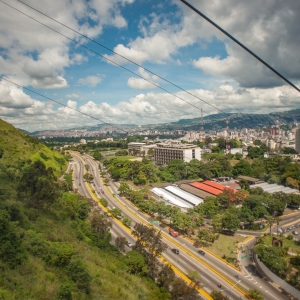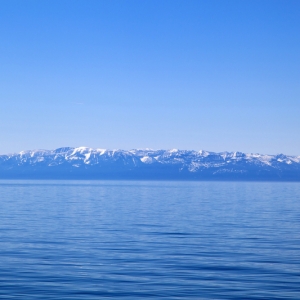Federal Water Tap, March 18: Trump Budget Proposes Big Cuts
The Rundown
President Trump once again recommends cutting spending. Historic floods sweep through the Missouri River basin. Trump signs a big public lands bill. The Defense Department objects to stricter PFAS cleanup standards. The GAO reports on disaster recovery in Puerto Rico. The Bureau of Reclamation publishes a final environmental review of two linked reservoir projects in Washington state. Burning Man might grow larger. And lastly, a Senate committee schedules an Interior secretary confirmation hearing and a hearing on Colorado River water conservation plans.
“I urge you to resist these or any other efforts to weaken the clean-up standards and quickly finalize guidelines that are sufficiently protective of human health and the environment.” — Sen. Tom Carper (D-DE), writing in a letter to Andrew Wheeler, the EPA administrator, asking him not to bow to pressure from the Defense Department to weaken groundwater cleanup standards for two PFAS chemicals.
By the Numbers
55: Percent of their full contract amount that farm districts south of the Sacramento-San Joaquin delta will receive this year from the Central Valley Project. The allocation will be updated as final water supply totals become clearer. (Bureau of Reclamation)
100,000: People who would be allowed to attend Burning Man, an annual arts festival in the Nevada desert, under a permit application that is under consideration. Attendance is currently capped at 70,000. Up to 16.5 million gallons of water, sourced from wells on a ranch owned by the event organizer, would be used for the festival. (Bureau of Land Management)
News Briefs
Trump Budget
Predictably, it was a slasher.
President Trump’s fiscal year 2020 spending plan proposes cutting the U.S. Environmental Protection Agency’s budget by 31 percent, to just under $6.1 billion. The proposed number of full-time employees (12,414) would be the lowest since Ronald Reagan’s second term. The budget also recommends cutting funding for Great Lakes ecosystem cleanup by 90 percent and contributions to two water infrastructure loan funds by 31 percent.
The president’s budget, however, is best viewed not as a budget, but as a statement of principles that indicates priorities. It is Congress that writes the checks. In recent years lawmakers have dismissed the deep cuts offered by the administration. There is already bipartisan pushback from Great Lakes governors and representatives about cleanup funding.
Even though the president’s budget is a policy document, it is important to keep in mind. The administration can try not to spend the money it is granted and pull back the funds through a process called rescission. The Senate rejected such an attempt last year to cut $15 billion in federal spending. (For more on the rescission process, see here.)
Missouri River Floods
Federal agencies are responding to historic flooding in the Midwest, caused by heavy rain, ice jams, and snowmelt.
As of early Monday morning, 17 river gauges in the basin were above major flood stage, according to the National Weather Service. The Missouri River at Plattsmouth, Nebraska, crested at 40.6 feet on Saturday afternoon, nearly 4 feet higher than the previous record.
Rivers in Nebraska have largely crested as the swell of water moves downstream.
FEMA reports that wastewater plants in Kansas and Nebraska are discharging sewage into the Missouri River while the water treatment plant in Peru, Nebraska lost power due to flooding.
The Army Corps of Engineers, which operates large dams in the basin, is slowly reducing water releases from Gavins Point Dam, in South Dakota. The Corps ramped up releases five-fold on Friday morning, to 100,000 cubic feet per second, to keep within operating limits.
Agencies Object to PFAS Standards
The Defense Department, NASA, and the Small Business Administration are pushing back against chemical cleanup standards proposed by the EPA, the New York Times reports.
The standards, which would apply to PFAS chemicals found in groundwater, have been held up in interagency review since August.
The EPA is seeking a 70 parts per trillion standard for the two most-studied chemicals, but the Defense Department, which faces potentially billions in cleanup costs, wants a standard of 380 parts per trillion.
Sen. Tom Carper, the top Democrat on the committee that oversees the EPA, asked agency leaders not to cave to pleas less strict standards.
“I urge you to resist these or any other efforts to weaken the clean-up standards and quickly finalize guidelines that are sufficiently protective of human health and the environment,” Carper wrote in a letter to Andrew Wheeler, the EPA administrator.
Public Lands Bill Signed
President Trump signed a bipartisan package of bills that protect public lands and waters.
The bill defines scores of river segments in Oregon as wild and scenic, and designates National Heritage Areas in the Santa Cruz Valley (Arizona), Sacramento-San Joaquin delta (California), and Susquehanna Valley (Pennsylvania).
It also removes more than 340,000 acres in Washington state’s Methow Valley from mining activity, and it permanently reauthorizes a fund for purchasing land for parks and trails.
Studies and Reports
Hurricane Recovery in Puerto Rico
Congress directed $4 billion in emergency aid to Puerto Rico following Hurricane Maria, in September 2017. A year later, at the end of September 2018, only $1.7 billion of that sum had been spent, according to a U.S. Government Accountability Office report.
Puerto Rico is the first jurisdiction to use new accounting rules for all permanent recovery projects following a disaster — things like road repair and fixing the water system. Meant to speed up construction and provide more flexibility, the rules were established by Congress in 2013 after Hurricane Sandy.
The new procedures allow for reimbursement not based on direct cost, but rather on an estimated cost. If the project is over budget, the local jurisdiction covers the overrun. If under budget, it can use the surplus for additional authorized purposes, such as making local infrastructure more resilient to future hazards.
Yakima Basin Dam Infrastructure
The Bureau of Reclamation and Washington Department of Ecology released a final environmental review of two interconnected water infrastructure projects in the Yakima watershed of Washington state.
One project is a pumping station in Kachess reservoir that would be used when water levels drop below the current outlets. Building a floating pumping station (estimated construction cost: $166 million) is the preferred course of action, according to the review. The project would be designed, built, maintained, and funded by Roza Irrigation District, which supplies water to high-value orchards.
The other is a 4-mile pipeline connecting Kachess with Kecheelus reservoir, another water storage facility in the Yakima headwaters. The pipeline would, in theory, allow water from Kecheelus to refill the other reservoir after the pumping station is used. The pipeline (construction cost: $240 million) would be built only in tandem with the pumping station.
On the Radar
Colorado River Hearing
On March 27, the Senate Energy and Natural Resources Committee holds a hearing on water conservation plans in the Colorado River basin.
Interior Confirmation Hearing
The next day, March 28, the committee gathers to question David Bernhardt, President Trump’s nominee to lead the Interior Department.
A former lobbyist and lawyer that represented water districts and oil, gas, and mining companies as well as the department’s top lawyer during the George W. Bush administration, Bernhardt is currently the acting Interior secretary, a role he assumed after Ryan Zinke resigned in December.
Federal Water Tap is a weekly digest spotting trends in U.S. government water policy. To get more water news, follow Circle of Blue on Twitter and sign up for our newsletter.
Brett writes about agriculture, energy, infrastructure, and the politics and economics of water in the United States. He also writes the Federal Water Tap, Circle of Blue’s weekly digest of U.S. government water news. He is the winner of two Society of Environmental Journalists reporting awards, one of the top honors in American environmental journalism: first place for explanatory reporting for a series on septic system pollution in the United States(2016) and third place for beat reporting in a small market (2014). He received the Sierra Club’s Distinguished Service Award in 2018. Brett lives in Seattle, where he hikes the mountains and bakes pies. Contact Brett Walton






Leave a Reply
Want to join the discussion?Feel free to contribute!